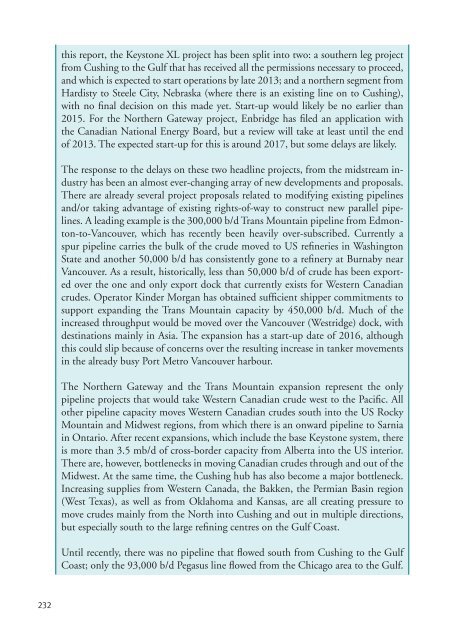World Oil Outlook - Opec
World Oil Outlook - Opec
World Oil Outlook - Opec
- TAGS
- world
- outlook
- opec
- www.opec.org
Create successful ePaper yourself
Turn your PDF publications into a flip-book with our unique Google optimized e-Paper software.
232<br />
this report, the Keystone XL project has been split into two: a southern leg project<br />
from Cushing to the Gulf that has received all the permissions necessary to proceed,<br />
and which is expected to start operations by late 2013; and a northern segment from<br />
Hardisty to Steele City, Nebraska (where there is an existing line on to Cushing),<br />
with no final decision on this made yet. Start-up would likely be no earlier than<br />
2015. For the Northern Gateway project, Enbridge has filed an application with<br />
the Canadian National Energy Board, but a review will take at least until the end<br />
of 2013. The expected start-up for this is around 2017, but some delays are likely.<br />
The response to the delays on these two headline projects, from the midstream industry<br />
has been an almost ever-changing array of new developments and proposals.<br />
There are already several project proposals related to modifying existing pipelines<br />
and/or taking advantage of existing rights-of-way to construct new parallel pipelines.<br />
A leading example is the 300,000 b/d Trans Mountain pipeline from Edmonton-to-Vancouver,<br />
which has recently been heavily over-subscribed. Currently a<br />
spur pipeline carries the bulk of the crude moved to US refineries in Washington<br />
State and another 50,000 b/d has consistently gone to a refinery at Burnaby near<br />
Vancouver. As a result, historically, less than 50,000 b/d of crude has been exported<br />
over the one and only export dock that currently exists for Western Canadian<br />
crudes. Operator Kinder Morgan has obtained sufficient shipper commitments to<br />
support expanding the Trans Mountain capacity by 450,000 b/d. Much of the<br />
increased throughput would be moved over the Vancouver (Westridge) dock, with<br />
destinations mainly in Asia. The expansion has a start-up date of 2016, although<br />
this could slip because of concerns over the resulting increase in tanker movements<br />
in the already busy Port Metro Vancouver harbour.<br />
The Northern Gateway and the Trans Mountain expansion represent the only<br />
pipeline projects that would take Western Canadian crude west to the Pacific. All<br />
other pipeline capacity moves Western Canadian crudes south into the US Rocky<br />
Mountain and Midwest regions, from which there is an onward pipeline to Sarnia<br />
in Ontario. After recent expansions, which include the base Keystone system, there<br />
is more than 3.5 mb/d of cross-border capacity from Alberta into the US interior.<br />
There are, however, bottlenecks in moving Canadian crudes through and out of the<br />
Midwest. At the same time, the Cushing hub has also become a major bottleneck.<br />
Increasing supplies from Western Canada, the Bakken, the Permian Basin region<br />
(West Texas), as well as from Oklahoma and Kansas, are all creating pressure to<br />
move crudes mainly from the North into Cushing and out in multiple directions,<br />
but especially south to the large refining centres on the Gulf Coast.<br />
Until recently, there was no pipeline that flowed south from Cushing to the Gulf<br />
Coast; only the 93,000 b/d Pegasus line flowed from the Chicago area to the Gulf.
















